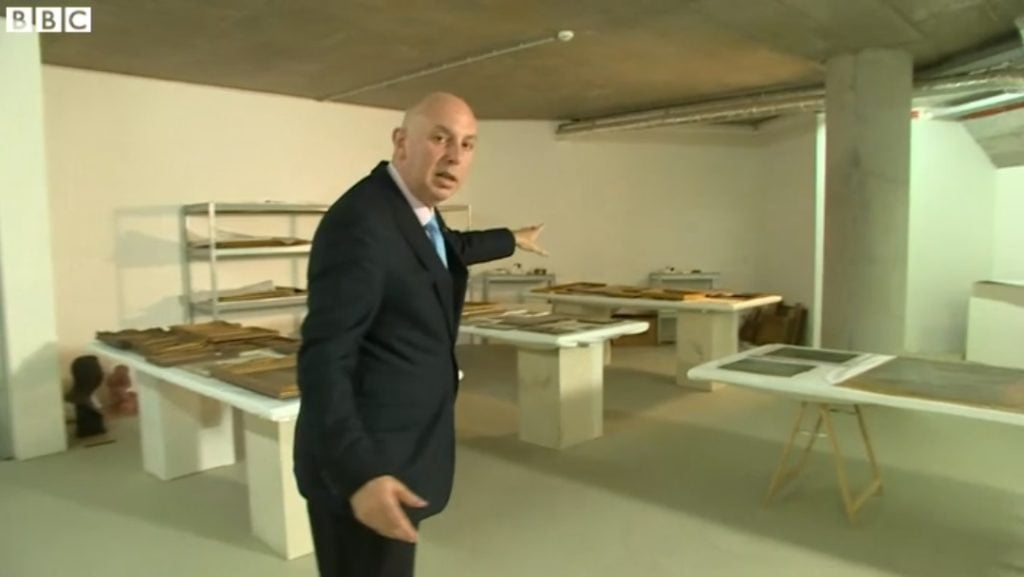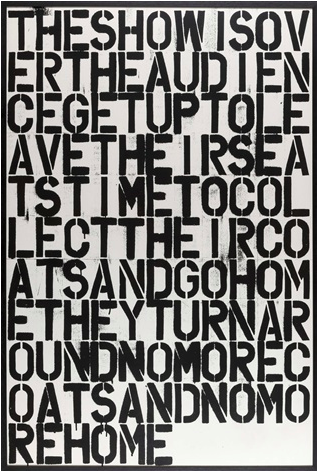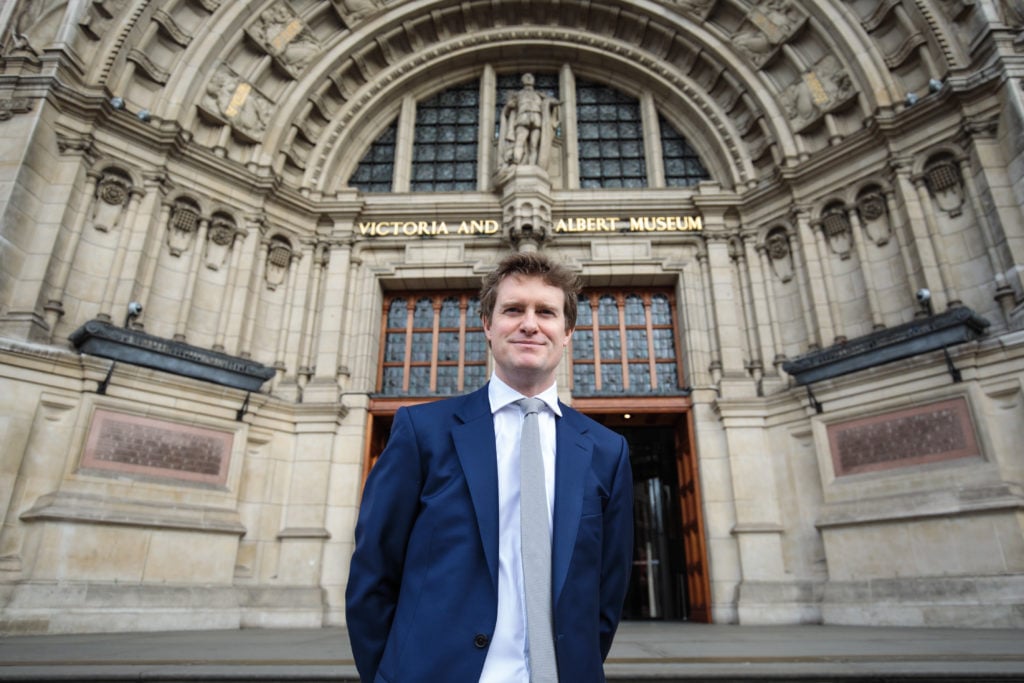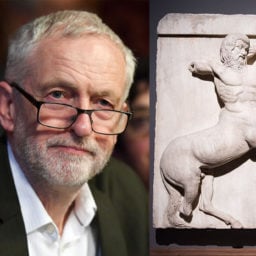Every Monday morning, artnet News brings you The Gray Market. The column decodes important stories from the previous week—and offers unparalleled insight into the inner workings of the art industry in the process.
This week, stories about the eternal conflict between stasis and change….
KEEP IT IN NEUTRAL(?)
On Monday, Tristram Hunt, the director of London’s Victoria & Albert Museum, penned an op-ed in The Art Newspaper defending the decision to exhibit pieces of a historic housing project outside the V&A’s pavilion at the 2018 Venice Architecture Biennale.
The museum owns “a three-story façade and interior flat fittings” from Robin Hood Gardens, a low-income housing complex and New Brutalist “masterwork” designed by Alison and Peter Smithson in 1970. Critics on the left now charge that the V&A’s choice to acquire and display these pieces in a prestigious institutional setting tacitly endorses the gentrification wave now crashing onto the building’s former east London neighborhood.
Zooming out further, Hunt argues that the fire and fury directed at the V&A owes to “the increasingly popular conviction that not only can museums not be neutral sites, but that they also have a duty to be vehicles for social justice.” He goes on to advocate for his conception of “the role of the museum not as a political force, but as a civic exchange: curating shared space for unsafe ideas.”
He also charges that this function is “more important than ever” in “an era of absolutist, righteous identity politics”—one that he contends is being fought by “keyboard warriors and ‘art-wash’ agitators” frantically flitting between more pots to stir than a workaholic witches’ coven.
Broadly speaking, I agree with Hunt about the ideal role of the museum. I worry—a lot—about polarization and the loss of nuance in all aspects of contemporary culture. It’s the single factor that scares me most about our ability to find sustainable solutions to hard problems on a whole range of critical issues, even more so outside the arts than inside.

The Robin Hood Gardens Estate mid-demolition. Photo by Chris J Ratcliffe/Getty Images.
At the same time, most museums are struggling financially, thanks in no small part to dwindling government funding, and attendance is not tracking with the growth and increasing diversity of the general population. At some point, it’s inevitable that some leaders somewhere will ask themselves whether taking political action could position them better with the sensibilities of the audiences they need to court to stay relevant (and solvent) in the future.
As a reminder, museums as we generally think of them today are neither all that old nor all that fixed in their identity. The V&A has existed for fewer than 250 years, yet it’s still one of the model’s eldest. “Curator” wasn’t a profession until the 20th century, meaning museum collections have only been curated for a few decades more than cocktails or salad. And even some of the most prestigious arts institutions in the world are just now radically reshaping fundamental traits like their admission policy and programming strategy.
Is it implausible that museum leadership could follow the same logic as the major brands—like Gucci, Delta Airlines, and Adidas—that have recently pivoted into deliberate stances on what would previously have been viewed as third-rail social and political issues, partly because some data shows that, at least in the US, the majority of the population now wants their brands to have an opinion?
Personally, I don’t think so. I’m confident that Hunt is still very comfortably in the majority among his peers on this issue at present. But if current funding and demographic trends continue, I also know this: Survival instincts have compelled people to do far wilder things than abandon neutrality before. And with contemporary life driving political polarization to new levels worldwide, the appeal of “shared spaces” ain’t what it used to be.
[The Art Newspaper]

Video still of BBC correspondent Stephen Evans visiting the secret storage facility that then housed the art collection of Cornelius Gurlitt, now known as the avatar for acquiring works illegally and unethically seized by the Nazis between 1933 and 1945.
LEAD, ZEPPELIN
Last Friday, The Economist examined the unorthodox, enlightened approach taken by Germany’s Zeppelin Museum—which, FYI, collects neither blimps nor memorabilia from historically debauched ‘70s rock gods—toward the provenance of the artworks on view in its current exhibition. Despite the institution’s relatively small stature, its leaders have set a new standard for transparency in the murky waters of (potentially) misbegotten art.
“The Obligation of Ownership: An Art Collection Under Scrutiny” includes dozens of the nearly 4,000 pieces in the museum’s permanent collection. Yet what sets this show apart is that the works’ origins—and the lingering questions around them—are as much on display as the works themselves.
The curators have installed each painting, work on paper, and sculpture to showcase the identifying marks added by past owners, broadcasting their behind-the-scenes historical record for all to see. Wall text and supporting materials expand on important findings.
Even more compelling, “The exhibition’s transparent, systematic research is made clear to even the casual observer with a ‘looting danger’ classification system of green, yellow, orange, and red stickers on the artwork’s card.”
If you’re keeping score, “around half the labels are green, and almost as many are yellow. Only two have been assigned the more precarious orange, and none are labelled red.”
At the same time, museum officials emphasize that they are still digging into the past, meaning new information could disrupt some of the current classifications at any moment. Which is all the more reason this effort strikes me as so commendable.
While it’s not a stall tactic in every instance, requesting more time for research is one of mankind’s most time-honored methods for staving off embarrassing results. At some point, the research can easily transform from a fact-finding quest into a smoke-bomb plume allowing you to retreat from responsibility unscathed. As long as you’re still probing, no one can definitively say you screwed up, let alone compel you to face the consequences.
To their credit, the Zeppelin Museum is offering the best of both worlds. They seem to be taking further provenance research seriously, while literally shining floodlights on what they’ve learned about the collection right now. They’re showing their work in both senses of the phrase, and letting the public judge whether the knowledge gaps on display threaten the legitimacy of the collection.
It’s a refreshingly mature, nuanced way to handle a complex issue. Hopefully the art industry can learn from it on a conceptual level as much as one specific to restitution, because we could desperately use it on everything from art market reports to pricing to appraisals.
[The Economist]

Felix Gonzalez-Torres. Courtesy of YouTube.
FULL STACK DEVELOPERS
Finally this week, artist, writer, and fellow minutiae-hound Greg Allen broke down a phenomenon playing out around works by the late Felix Gonzalez-Torres—one whose mechanics illuminate an important point about how the art market has changed in a digital age.
At the center of this curiosity are Gonzalez-Torres’s “stack” works: towers of endlessly reproducible and replaceable objects. Usually (though not always), viewers are encouraged to take individual units of the stacks as free souvenirs. And usually (though not always), the stacks consist of hundreds of sheets of the same print.
Now, it isn’t that you can’t resell individual sheets from authentic Gonzalez-Torres stacks. It’s just that, according to the artist, they are not artworks in and of themselves. Instead, each is a free-for-the-taking, infinitely duplicative component of a full artwork. And according to the certificate of authenticity, that full artwork’s “uniqueness is defined by ownership.”
In Gonzalez-Torres’s conception, then, the only person who possesses “the artwork”—the thing with value—is the one who paid for the full stack. That purchase gives the owner huge influence, if not quite total control, over how the individual sheets filter out to others. Everyone else is just snatching ephemera.
To help ground all the conceptualism, think about it this way: You know how if you buy a bag of Halloween candy, the wrappers on the individual bars inside always include text reading something like, “Not intended for individual resale”? This is basically the high art equivalent.
And yet, selling individual sheets from Gonzalez-Torres Stacks as artworks is exactly what some have been doing—especially online, and extra-especially for the stack work Felix did with the market darling Christopher Wool. Usually (though not always), sheet prices range from a few hundred to several thousand dollars each. And sellers have ranged from eBay soloists to physical auction houses (like Wright and Rago) to online middlemen (like Artsy, Paddle8, and yes, artnet).

Sheet from Felix Gonzalez-Torres and Christopher Wool’s collaborative stack work. Image courtesy of artnet.
Allen reports that one eBay seller even offered a “first edition” sheet for $12,500. A “first edition” is a nonsense concept here, since the whole point of the stacks is that every replacement sheet ever produced will always be exactly the same as the first run. But necessity is the mother of invention, I suppose.
On one level, this conundrum is a great distillation of the entire art market: Objects with no inherent value are being traded for prices determined by the perception of some greater worth, usually (though not always) transcendence and/or prestige and/or social capital. The machinations of perceived value can be so strong, in fact, that they can even complicate the artist’s own intent.
As Allen puts it:
Felix wanted as many viewers as wanted them to take sheets from his stacks for free, but this turns out to be not the same as free to obtain or endlessly available. They’re not all in publicly accessible collections. They’re not always on view, and they’re probably not close by when they are. So the constraints and complications of getting in a room with the Felix stack you want have real costs, and the way we weigh these costs against the desire to possess a thing is called money.
In that sense, I would invert Allen’s notion that “people buy [the sheets] because they are for sale.” I think it’s more accurate to say that people sell the sheets because they have buyers.
But something more 21st-century is happening here, too.
Markets materialize wherever willing supply can meet unsatisfied demand. Prior to the internet, though, where would there have been enough demand to make a market for individual Gonzalez-Torres sheets?
How many people even knew who Felix or Wool were before Instagram, blogging, and online art media? More to the point, how many would have had the desire and capital to pay thousands of dollars for something of theirs known to be free, based on the larger psychic cachet they could attain from owning it?
Even more telling, how would someone with a supply of Gonzalez-Torres sheets have known buyers were willing to pay those prices for them, at least in an efficient enough way to make selling them feasible?
What would they have done, set up a stand outside a museum next to the caricature artists and hot dog vendors? Sidle up to art students at dive bars with a three-ring binder full of inventory? Start going door to door at studio complexes like 1950s vacuum cleaner salesmen?
No, you needed the internet. It’s the only thing that could simultaneously heighten an artist’s visibility, alter his work’s context, and streamline the mechanics of a marketplace enough to create this action. So the next time you hear someone talk about the “democratization of the art market” as an unqualified improvement, remind them that, even in a democracy, some people will pay a premium for access.
[Greg.org]
That’s all for this week. ‘Til next time, remember: Change is sometimes good, sometimes bad, but always coming.












